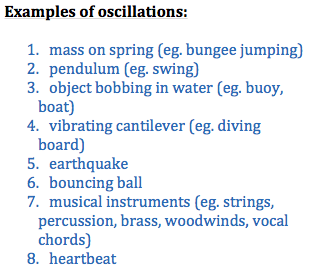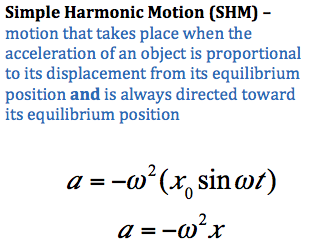Cards In This Set
| Front | Back |
|
4.1.1Describe examples of Oscillations
|
 Refer to the image for the answer |
|
4.1.2Define the terms displacement, amplitude, frequency, period and phase difference
|
 Refer to the image for the answer |
|
4.1.3Define simple harmonic motion and state the defining equation, a = -w2x
|
 Refer to the image for the answer |
|
4.2.1Describe the interchange between kinetic energy and potential energy during simple harmonic motion
|
 Refer to the image for the answer |
|
4.3.1State what is meant by damping
|
 Refer to the image for the answer |
|
4.3.2Describe examples of damped oscillations
|
 Refer to the image for the answer |
|
4.3.3State the meaning of natural frequency and forced oscillations
|
 Refer to the image for the answer |
|
4.3.4Describe graphically the variation of the amplitude of a vibrating object when the forced frequency is close to its natural frequency of the object
|
 Refer to the image for the answer |
|
4.3.5State what is meant by resonance
|
 Refer to the image for the answer |
|
4.3.6Describe examples of resonance where the effect is useful and where it should be avoided
|
 Refer to the image for the answer |
|
4.4.1Describe a wave pulse and a continuous progressive (traveling) wave
|
 Refer to the image for the answer |
|
4.4.2State the progressive (traveling) waves transfer energy
|
Progressive (traveling) waves transfer energy
|
|
4.4.3Describe and give examples of transverse and longitudinal waves
|
 Refer to the image for the answer |
|
4.4.4Describe waves in two dimensions, including concepts of wavefronts and rays
|
 Refer to the image for the answer |
|
4.4.5Describe the terms crest, trough, compression and rarefaction
|
 Refer to the image for the answer |



